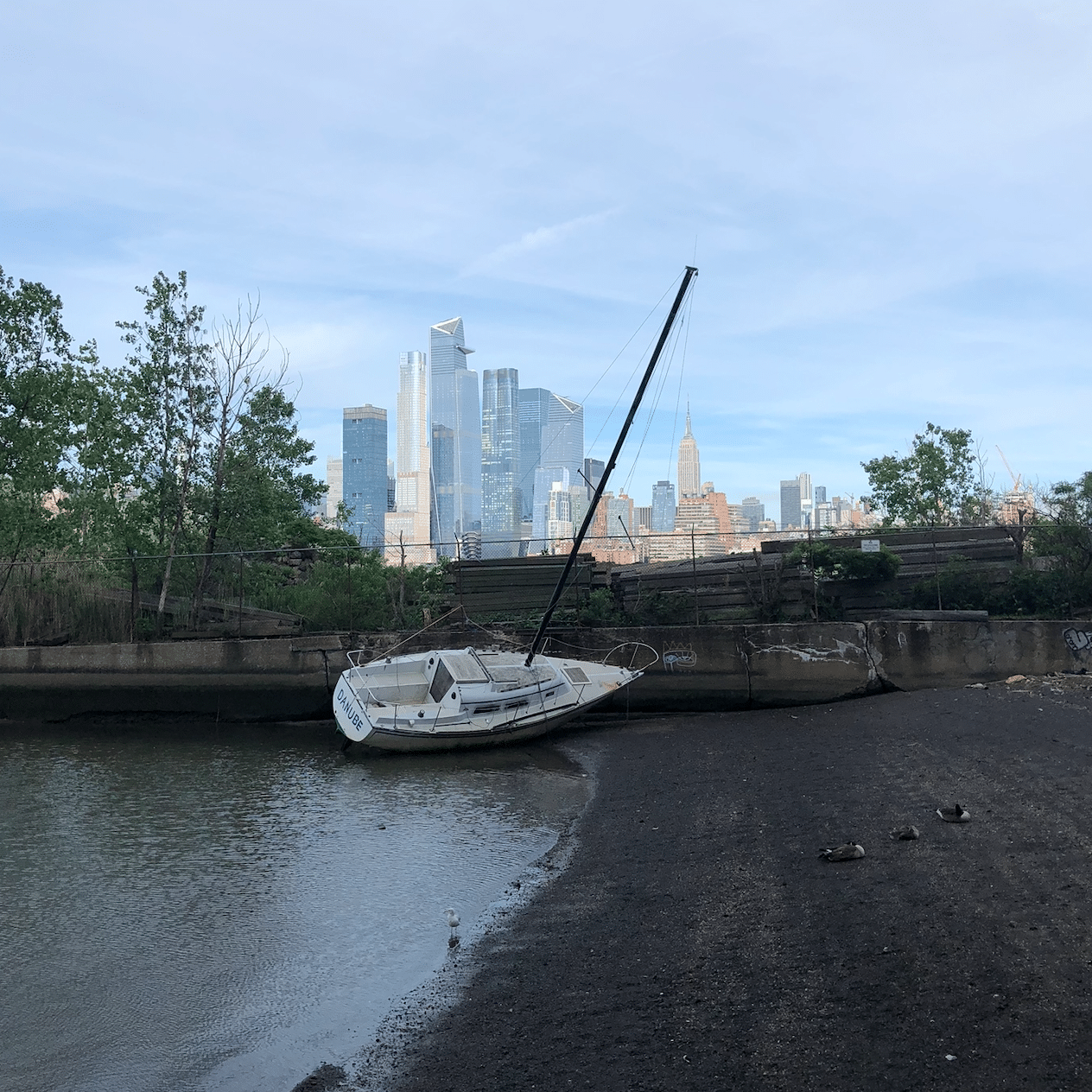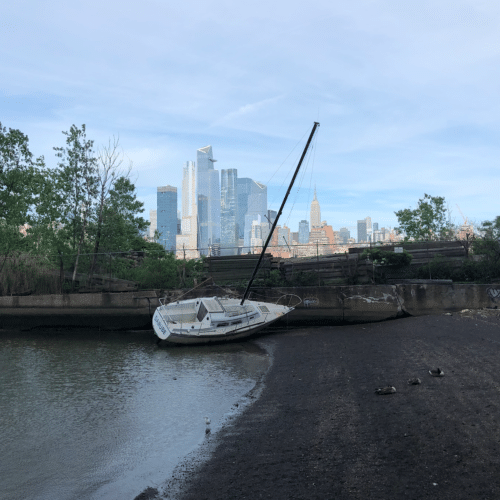Hoboken: a thriving waterfront community or a growing boat graveyard? Well, the truth is, it looks like our beloved Mile Square is actually both.
An unprecedented amount of messages regarding the sunken and abandoned boats in Hoboken waters have inundated the Hoboken Girl inbox. Residents want to know: Who do these boats belong to? How long have they been in the water? Why are they still in the water? And most mysteriously, whose responsibility is it to get them out?

The boats in question are mainly grouped in an area called Weehawken Cove. Over the years, everyone from residents to local pilots have captured some pretty eerie photographs of what has become known as “the boat graveyard.” And though it has become the norm, many still want to know the story behind the boats as well as what can be done to remove them.
On September 8th, Councilwoman Tiffanie Fisher updated her constituents in a newsletter with the status of the boats saying, “It is difficult to justify incurring significant costs to remove the boats with the sunken boats costing much more than the ones abandoned and still floating.” However, Councilwoman Fisher explained that Hoboken Fire Chief Crimmins has led a small group of representatives who have worked together to inventory and identify the owners of all the current boats and remove a few along the way. Recently in working with Environmental Services Director Jennifer Gonzalez, they are now applying for a NOAA Marine Debris Removal grant to remove the boats. They are currently waiting to hear back on the acceptance of the grant.
To sign the sailboat grant letter of support for the National Oceanic and Atmospheric Administration from Mayor Bhalla, Fire Chief Brian Crimmins, and Environmental Services Director Jennifer Gonzalez, click here.
Hoboken Girl reached out to local government representatives, the Mayor’s Office, a member of the Coast Guard {who would prefer to remain anonymous}, and an ecological expert to examine the story behind the sunken and abandoned boats, as well as their impact.
Keep reading for frequently asked questions about the sunken boats in Hoboken:
What’s the story behind the sunken and abandoned boats?
The sunken and abandoned boats in Weehawken Cove have been gaining media attention as early as 2015, according to a piece published by CBS New York Local News that year. However, the story behind the boats might go even further back than that. Some seem to think that several of the boats were sunk as a result of Superstorm Sandy, which ravaged Hoboken in the fall of 2012.
Of course, the most infamous boat sunk by Superstorm Sandy {which was transported by the hurricane into town} has since been removed, painted pink, and placed outside of Surf City in Jersey City. While some of the boats may have been sunken or abandoned since as far back as 2012, others have capsized as a result of other storms.
See More: Wildlife Sightings in Hudson County: The Growing List of Animals Residents Have Spotted
There are two main kinds of boats that are plaguing the Weehawken Cove {and other areas along Hoboken waters}. Some are half-sunken boats, visually submerged in water, while others are simply abandoned boats that either haven’t been tended to or have washed up onshore.
It’s important to note that while the half-sunken, submerged boats are very clearly not in use, a significant issue with both the submerged boats and the abandoned boats is identifying ownership.
Well, there’s a record, right? Not really. In fact, that’s one of the biggest components of the mystery.
Anchoring a boat in Weehawken Cove is free — in fact, it’s one of the only nearby areas where it is free to do so. In 2015, then-manager of Hoboken Sailing Club Kevin O’Brien said, “If you can’t afford to put your boat anywhere, they put them here.”
And it makes sense, however, when a storm rolls through the community, these boats — which anchor there for free — often capsize and are never claimed again. The result? It has lead to a mass abandonment of boats and owners who refuse to claim their ships.
How many sunken boats are there in Hoboken waters?
In the original CBS New York article from 2015, it’s mentioned that Weehawken Cove holds two mysterious, sunken sailboats. “A couple more look, well, left for dead, CBS2’s Vanessa Murdock reported Friday.”
But if the number did in fact start at two in 2015, then it has certainly grown over the past five years. According to an employee of the Coast Guard Sector New York Command Center — who prefers to remain anonymous — local waters hold at least 229 sunken or abandoned boats. Seven of these are reported to be in Weehawken Cove. These boats are known officially as “derelict vessels.”
“We have a record of every derelict vessel {VSL} in the Sector New York AOR dating back to Hurricane Sandy that has been reported to us,” the source tells Hoboken Girl via email. “Obviously, there are probably some that have not been reported to us but I would guess we have a record of 90 percent of the VSLs in our AOR.”
The source continues, “In the NYC and NJ area along the Hudson River, East River, and Sandy Hook Bay area, there are around 230 known VSLs. New York and New Jersey have different definitions of what a derelict VSL means and length at which a VSL is left abandoned.”
Whose responsibility is it to remove the derelict boats?
Again, this is a bit of a controversy as well as a mystery. Much of this derelict boat issue has been relegated to murky waters {pun intended} — as in it’s unclear whose job it is to take care of the removal of the boats.
As of 2015, the New Jersey State Police confirmed each of the vessels were under investigation. Then in 2018, the City of Hoboken passed an ordinance, officially giving the City jurisdiction over removal of the boats.
“The city passed an ordinance saying they would take jurisdiction over it,” City Councilwoman Tiffanie Fisher told CBS2 at the time.
At the time, a spokesperson for Mayor Bhalla’s office also confirmed, “All boats will be removed as soon as possible, including any vessel that sunk and is out of sight in the cove.” The Office also said that each owner of the boats had been identified and that the City would begin removal in just days.
However, it’s been two years and many of the derelict boats still remain.
According to our Coast Guard source, the Coast Guard receives multiple calls a year regarding this trove of boats. Not because it’s an eyesore, aesthetically, but because some boaters see half-sunken boats and send out a rescue call.
“Whenever the Coast Guard receives a report of a VSL adrift {without someone operating the VSL} or a VSL in the process of sinking, we have a duty to respond to that case,” the source tells Hoboken Girl. “That can either be in the form of launching Coast Guard assets {small boats from our station in NYC, or launching a helicopter from one of our air stations, usually in Atlantic City}, or we request assistance from our OGAs {other government agencies} in the port, such as NYPD, NY/NJ State Police, or members of the NJ Fire Boat Task Force, which is a collection of fire departments on the Jersey side of the Hudson River that have maritime assets.”
While it is the responsibility of the Coast Guard to conduct search and rescue calls, these particular boats are abandoned, so when the Coast Guard is deployed to “rescue” them, it results in a waste of resources, time, and money. In fact, the source estimates that thousands of dollars a year are being wasted to deploy rescue resources for these boats.
“When we get on the scene and deem it is an actual distress case, we go throw the process of what you would imagine a search is,” the anonymous source continues. “If our assets get on scene and report it is not a distress case, [meaning] obvious signs of non-usage, marine growth on the hull, VSL has been gutted of all electronics, ripped and tattered sails, no engine or means of propulsion, we then categorize the case as a derelict or abandoned VSL and close the case.”
Now, here’s an important distinction: If the VSL is in a federal, navigable waterway {such as the middle of the Hudson River}, then the Coast Guard can arrange for the VSL to be removed by one of the marine assets on the scene. But because Weehawken Cove is not a federal, navigable waterway, the Coast Guard can’t remove the boats.
“Because the VSLs in Weehawken Cove are not located in a federal, navigable waterway, the responsibility for removal of the VSL falls on the state and local level,” the anonymous source explains. “And because the Cove is parts of both Hoboken and Weehawken, I can imagine that increases the difficulty.”
At this point, the Coast Guard’s policy states that abandoned property should be officially disposed of by contacting the local municipality, county, or state agency in the region.
How much money do these derelict boats cost?
Sources agree the boats have not yet been removed mainly due to cost. Removal of each boat could cost upwards of $25,000 — cash that the City of Hoboken just doesn’t have right now, especially during its current state of the financial crisis.
But though the City might be avoiding taking care of these boats in an effort to cut back on costs, someone somewhere is still paying the price. Recall the aforementioned method of how the Coast Guard frequently has to respond to search and rescue calls for these boats.
As you can imagine, all of that effort, time, and resources computes to dollars spent.
“I will give you an example of a standard cost for the Coast Guard on one of these cases,” the anonymous source says. “If we received a report of an unmanned adrift VSL and we searched on it and the total time from case initiated to case closed was two hours, it would cost the Coast Guard $41,418.”
Read More: Hoboken History: The Birthplace of Baseball
What is the potential ecological impact of the submerged boats?
The Coast Guard is also responsible for assessing the pollution risk of derelict vessels.
“The pollution risk that we in the Coast Guard focus on is the risk of oil products entering the water: fuel, oil, hydraulic fluid, and so on,” the anonymous source explains. “If there is any type of fuel onboard those vessels and an owner cannot be identified, we will work with Environmental Protection Agency {EPA} to arrange for funding to remove the product that is onboard. If the owner of that vessel can be identified, it is their responsibility to ensure the removal of the product and we work to ensure that it does.”
As for our anonymous source’s personal opinion, pollution is unlikely. “In my opinion, the VSLs that we are aware of do not pose a risk of pollution, however, that is just my opinion.”
While pollution is a significant concern, many residents are also concerned about the potential ecological impact of the submerged boats. Aside from pollution, what impact could a shipwreck incur on a local habitat or ecosystem?
According to Namepa.net, shipwrecks can have both positive and negative effects on the local ecosystem. For starters, “Wrecks off the Hawaiian coast have created opportunities for the islands to grow ecologically, financially, historically, and culturally.”
While Hoboken’s sunken boats may not have resulted in the same financial, cultural, or historical boost as Hawaii’s infamous World War II wrecks, Hoboken Life poses an interesting idea: transforming Hoboken’s boat graveyard into a tourist site. That way, the Mile Square can profit from the derelict vessels similarly to how Hawaii has.
“One option no one seems to be considering would be in a similar vein as Sybil’s Cave: Declare the cove ‘Hoboken’s Boat Graveyard’ and offer tours, including scuba tours to view the legendary haunted wrecks,” Hoboken Life suggests. “If we’re going to have sunken boats littering the water, might as well make a buck off it!”
Though the Mile Square hasn’t yet reaped the benefits of potentially turning the boat graveyard into a tourist site, these shipwrecks do, of course, provide ecological opportunities for growth. Fish can hide from predators, seaweed and algae can reign supreme, etc.
“These wrecks can help the environment because, over time, they can become a viable habitat for many marine plants and animals, and [even] improve water quality,” Namepa.net states.
But these wrecks also come with negative impacts, as well.
“Researchers believe that the deterioration of wrecks will release harmful metals and chemicals that could potentially hurt future marine communities,” Namepa.net adds. “Marine archeologists are concerned by the environmental effects of the oil that resides in wrecks.
However, with oil not being an issue in Hoboken’s abandoned and submerged ships, only time will tell what the ecological impacts of these uncared for boats will be.
Our anonymous source adds, “The Coast Guard’s responsibility is to ensure that no lives are in danger and there is no risk of pollution from the VSLs. All the VSLs that are out there that the Coast Guard has been notified of have been checked by officers from this sector to ensure there is no risk of pollution.”
Got a news tip? Let us know — email us at hello@hobokengirl.com! We appreciate it.

Check out Hoboken Girl’s new Job Board here!










